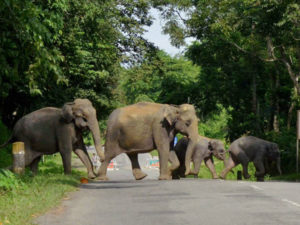NE UpdatesHappeningsBreaking News
Assam Forest department’s solar powered fences keep elephants away

August 2: In the wake of increasing man-elephant conflicts on forest fringes, the Assam Forest department’s solar powered electric fences at Rani and other areas have turned out to be an effective tool in keeping wild elephants at bay. The solar powered hanging fence has been installed on the fringe of Rani Reserve Forest to prevent wild elephants from straying into human habitations and paddy fields.

 The two km-long solar-powered fence from Nalapara to Belguri and from Mahindri to Silkhuta built at a cost of Rs.8 lakh under SoPD put up at Rani forest area under the Rani forest range in July 2020 has turned out to be an innovative solution to mitigate human-wildlife conflict. “The solar electric fence has helped overcome the problem of jumbos destroying human settlements and paddy fields,” said Range Officer, Manoranjan Barman.
The two km-long solar-powered fence from Nalapara to Belguri and from Mahindri to Silkhuta built at a cost of Rs.8 lakh under SoPD put up at Rani forest area under the Rani forest range in July 2020 has turned out to be an innovative solution to mitigate human-wildlife conflict. “The solar electric fence has helped overcome the problem of jumbos destroying human settlements and paddy fields,” said Range Officer, Manoranjan Barman.
 Dinesh Nath, a farmer from Moirapur village of greater Rani area said the solar fence has been able to ward off depredations by pachyderms in human settlements and helped save their paddy fields from being mowed down.
Dinesh Nath, a farmer from Moirapur village of greater Rani area said the solar fence has been able to ward off depredations by pachyderms in human settlements and helped save their paddy fields from being mowed down.
In Manas National Park, a five-km long hanging fence installed by Wildlife Trust of India in collaboration with the Forest department last year, has kept the jumbos out of human inhabited areas.
 “As the wires of the fence dangle down from a height, they are beyond the reach of elephant tusks,” said a forest official. Steel wires are hung in a row from a 3-m high horizontal overhead wire supported by posts on both ends. The wires would be connected to the solar power system and elephants would receive a mild shock if they try crossing through the hanging wires.
“As the wires of the fence dangle down from a height, they are beyond the reach of elephant tusks,” said a forest official. Steel wires are hung in a row from a 3-m high horizontal overhead wire supported by posts on both ends. The wires would be connected to the solar power system and elephants would receive a mild shock if they try crossing through the hanging wires.
 Forest officials said that the solution besides being cost effective when compared to conventional fences, has an advantage advantage in that if at all an elephant breached the fence and entered human habitations, it could be driven back to the forests by temporarily switching off the current flowing through the fence. Much earlier in 2014, at a site called Subankhata, on the eastern part of the Manas Tiger Reserve, Aaranyaka an NGO, persuaded local communities to convert their illegal electric fences into solar-powered electric fences that are non-fatal.
Forest officials said that the solution besides being cost effective when compared to conventional fences, has an advantage advantage in that if at all an elephant breached the fence and entered human habitations, it could be driven back to the forests by temporarily switching off the current flowing through the fence. Much earlier in 2014, at a site called Subankhata, on the eastern part of the Manas Tiger Reserve, Aaranyaka an NGO, persuaded local communities to convert their illegal electric fences into solar-powered electric fences that are non-fatal.
 With active participation from the villagers, a 14-km-long fence was erected that benefitted about 1,000 households as well as approximately 100-odd elephants that inhabit the area. Almost six and a half years down the line, the fences are still functional and no incidents of elephant or human deaths have occurred in the area.
With active participation from the villagers, a 14-km-long fence was erected that benefitted about 1,000 households as well as approximately 100-odd elephants that inhabit the area. Almost six and a half years down the line, the fences are still functional and no incidents of elephant or human deaths have occurred in the area.
In later years, a few more km of such fences were installed with improvised techniques. A total of 24.5 km of solar-powered electric fences were erected at two sites in Baksa district and 7.5 km in Nagaon district with support from the United States Fish and Wildlife Service, and Elephant Family India Foundation.
 In another instance, a solar-powered electric fence was installed in the premises of a primary school in Nagaon district, with the support of Center for Large Landscape, Montana University, USA. With this effort, about 10,000 households have benefitted. The fences are erected in such a manner that they encompass villages, without hampering the passage of elephants, thus fostering human-elephant coexistence..
In another instance, a solar-powered electric fence was installed in the premises of a primary school in Nagaon district, with the support of Center for Large Landscape, Montana University, USA. With this effort, about 10,000 households have benefitted. The fences are erected in such a manner that they encompass villages, without hampering the passage of elephants, thus fostering human-elephant coexistence..
 Hanging fences are a novel concept in human – elephant conflict management and have been used in Sri Lanka and also in southern India with promising results. “The major advantage of these fences are that they are much higher than conventional fences (14 ft) and are also electrically charged (solar) to give a mild shock to the pachyderms who learn and adapt to avoid interactions with the fences. These fences hang like a curtain with a gap underneath for smaller animals to cross and cannot be toppled easily by force,” said officials. The wires carry an average 9-kilovolt charge, the maximum being 11 kilovolts.
Hanging fences are a novel concept in human – elephant conflict management and have been used in Sri Lanka and also in southern India with promising results. “The major advantage of these fences are that they are much higher than conventional fences (14 ft) and are also electrically charged (solar) to give a mild shock to the pachyderms who learn and adapt to avoid interactions with the fences. These fences hang like a curtain with a gap underneath for smaller animals to cross and cannot be toppled easily by force,” said officials. The wires carry an average 9-kilovolt charge, the maximum being 11 kilovolts.
 In recent times, to mitigate human-elephant conflicts, the Government of Assam has launched anti-depredation squads of the Forest department, who are well-trained and better equipped to deal with such conflicts. “We hope that with proactive and pragmatic approaches, we can minimise human-elephant conflicts in the state and usher in coexistence,” said Environment and Forest Minister, Parimal Suklabaidya.
In recent times, to mitigate human-elephant conflicts, the Government of Assam has launched anti-depredation squads of the Forest department, who are well-trained and better equipped to deal with such conflicts. “We hope that with proactive and pragmatic approaches, we can minimise human-elephant conflicts in the state and usher in coexistence,” said Environment and Forest Minister, Parimal Suklabaidya.
Altogether 812 people have died due to human-elephant conflict in Assam during the last 10 years. The highest number of 115 deaths were reported from Udalguri district, followed by 103 in Sonitpur, 74 in Goalpara, and 51 in Darrang.




